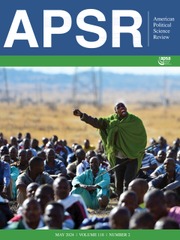Crossref Citations
This article has been cited by the following publications. This list is generated based on data provided by
Crossref.
Opoku-Agyemang, Kweku A.
2017.
Does Opening Complaints Data Change Company and Consumer Behavior? Evidence from the Consumer Financial Protection Bureau.
SSRN Electronic Journal ,
Hertel-Fernandez, Alexander
2018.
Policy Feedback as Political Weapon: Conservative Advocacy and the Demobilization of the Public Sector Labor Movement.
Perspectives on Politics,
Vol. 16,
Issue. 2,
p.
364.
Hertel-Fernandez, Alexander
and
Porter, Ethan
2018.
Bread and Butter or Bread and Roses? Experimental Evidence on Why Public Sector Employees Support Unions.
SSRN Electronic Journal,
Rad, Abdul
2018.
Police Institutions and Police Abuse: Evidence from the US.
SSRN Electronic Journal,
Wade, Magic M.
2018.
Targeting teachers while shielding cops? The politics of punishing enemies and rewarding friends in American state collective bargaining reform agendas.
Journal of Labor and Society,
Vol. 21,
Issue. 2,
p.
137.
Grumbach, Jacob M.
2018.
From Backwaters to Major Policymakers: Policy Polarization in the States, 1970–2014.
Perspectives on Politics,
Vol. 16,
Issue. 2,
p.
416.
Stegmueller, Daniel
Becher, Michael
and
Käppner, Konstantin
2018.
Labor Unions and Unequal Representation.
SSRN Electronic Journal ,
Grossmann, Matt
2019.
Red State Blues.
Lewis, Verlan
2019.
Ideas of Power.
Anzia, Sarah F.
2019.
Looking for Influence in All the Wrong Places: How Studying Subnational Policy Can Revive Research on Interest Groups.
The Journal of Politics,
Vol. 81,
Issue. 1,
p.
343.
Karch, Andrew
and
Rose, Shanna
2019.
Responsive States.
Paglayan, Agustina S.
2019.
Public‐Sector Unions and the Size of Government.
American Journal of Political Science,
Vol. 63,
Issue. 1,
p.
21.
Hertel-Fernandez, Alexander
2019.
Asymmetric Partisan Polarization, Labor Policy, and Cross-State Political Power-Building.
The ANNALS of the American Academy of Political and Social Science,
Vol. 685,
Issue. 1,
p.
64.
Patashnik, Eric M.
2019.
Limiting Policy Backlash: Strategies for Taming Countercoalitions in an Era of Polarization.
The ANNALS of the American Academy of Political and Social Science,
Vol. 685,
Issue. 1,
p.
47.
Macdonald, David
2019.
Labor Unions and Support for Redistribution in an Era of Inequality*.
Social Science Quarterly,
Vol. 100,
Issue. 4,
p.
1197.
Galvin, Daniel J.
2019.
From Labor Law to Employment Law: The Changing Politics of Workers’ Rights.
Studies in American Political Development,
Vol. 33,
Issue. 1,
p.
50.
Hertel-Fernandez, Alexander
2020.
Power and Politics in America’s Private Governments.
The Journal of Politics,
Vol. 82,
Issue. 1,
p.
e13.
Trachtman, Samuel
2020.
When State Policy Makes National Politics: The Case of “Obamacare” Marketplace Implementation.
Journal of Health Politics, Policy and Law,
Vol. 45,
Issue. 1,
p.
111.
Busemeyer, Marius R.
2020.
The European Social Model under Pressure.
p.
15.
Hacker, Jacob S.
Hertel-Fernandez, Alexander
Pierson, Paul
and
Thelen, Kathleen
2021.
The American Political Economy.




